Report on Sustainability in the Construction Industry Practices
VerifiedAdded on 2023/06/11
|9
|2660
|160
Report
AI Summary
This report examines the growing importance of sustainability in the construction industry, driven by climate change, resource limitations, government regulations, and consumer demand. It discusses the benefits of sustainable construction, including healthier living, reduced costs, waste minimization, experimentation opportunities, efficient material usage, and environmental protection. The report highlights the increasing consumer demand for environmentally friendly construction practices and materials. Various sustainable construction methods are explored, such as solar power, biodegradable materials, green insulation, cool roofs, and low-emitting materials. It also addresses the challenges of adopting sustainable practices, including cost pressures, high carbon emissions, and a lack of understanding of urban and building system relationships. Examples of companies like Skanska, Mace and Lend Lease are provided who are taking initiatives for sustainable construction. The report concludes that sustainability is crucial in the construction industry and requires a collective effort to mitigate environmental impact and meet consumer expectations. Desklib offers a range of solved assignments and resources for students.
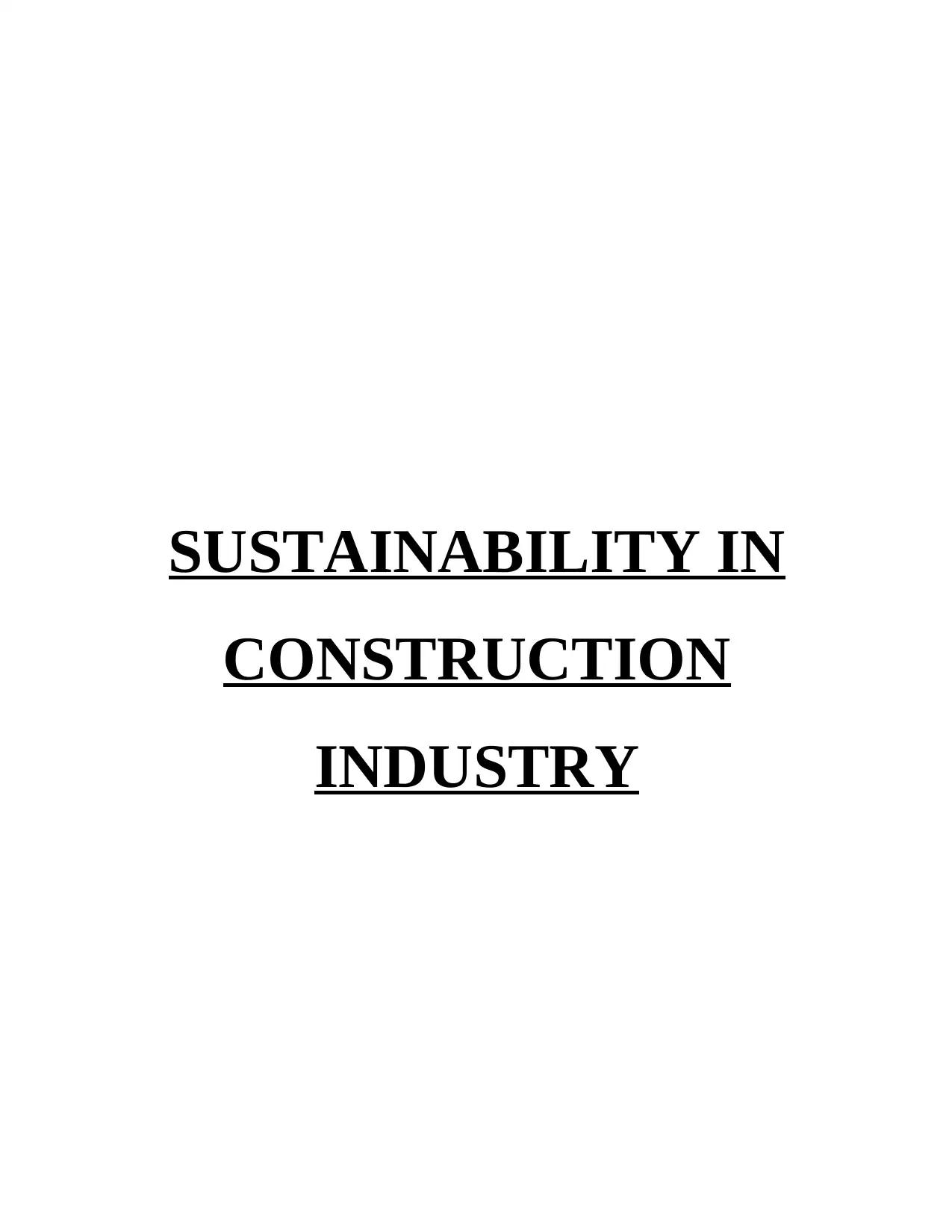
SUSTAINABILITY IN
CONSTRUCTION
INDUSTRY
CONSTRUCTION
INDUSTRY
Paraphrase This Document
Need a fresh take? Get an instant paraphrase of this document with our AI Paraphraser
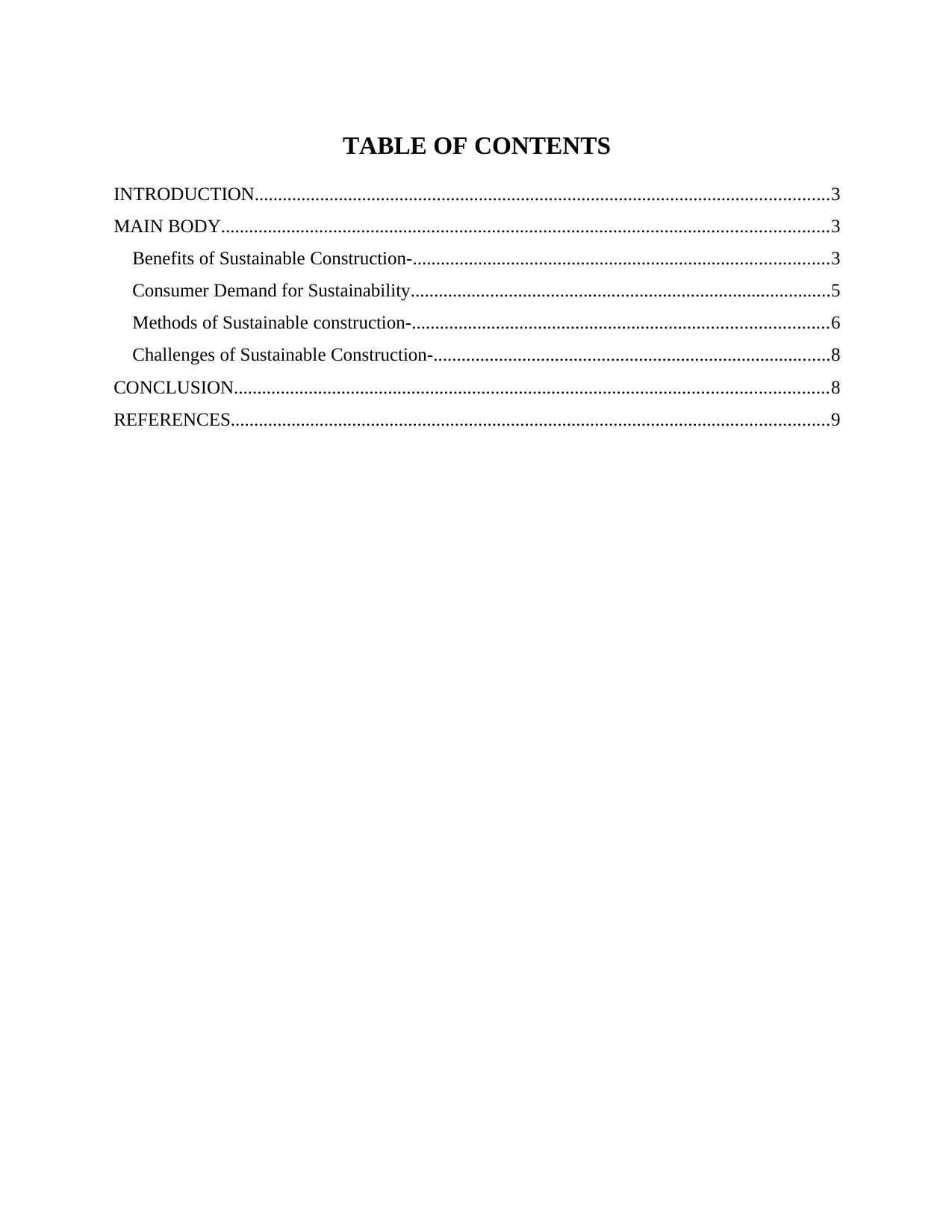
TABLE OF CONTENTS
INTRODUCTION...........................................................................................................................3
MAIN BODY..................................................................................................................................3
Benefits of Sustainable Construction-.........................................................................................3
Consumer Demand for Sustainability..........................................................................................5
Methods of Sustainable construction-.........................................................................................6
Challenges of Sustainable Construction-.....................................................................................8
CONCLUSION...............................................................................................................................8
REFERENCES................................................................................................................................9
INTRODUCTION...........................................................................................................................3
MAIN BODY..................................................................................................................................3
Benefits of Sustainable Construction-.........................................................................................3
Consumer Demand for Sustainability..........................................................................................5
Methods of Sustainable construction-.........................................................................................6
Challenges of Sustainable Construction-.....................................................................................8
CONCLUSION...............................................................................................................................8
REFERENCES................................................................................................................................9
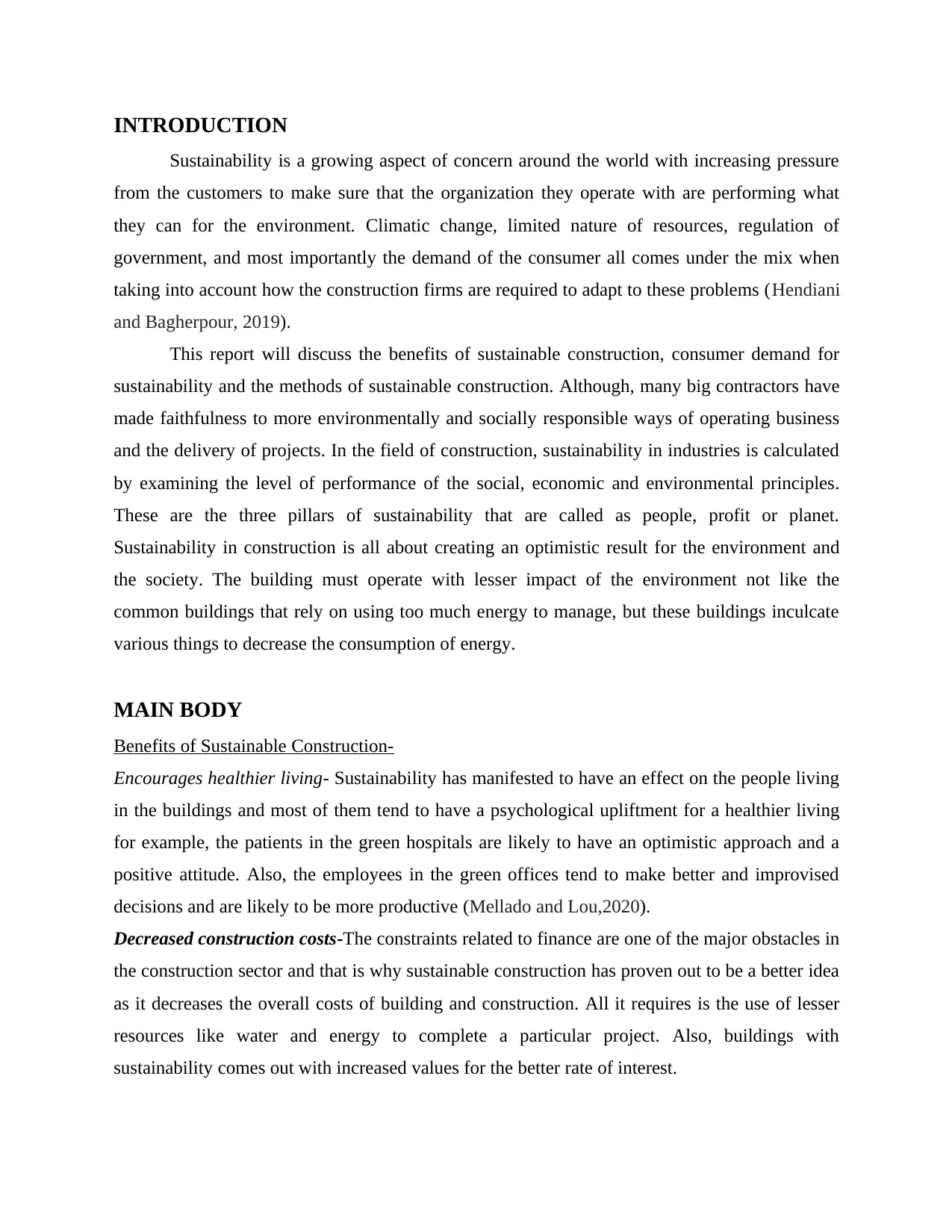
INTRODUCTION
Sustainability is a growing aspect of concern around the world with increasing pressure
from the customers to make sure that the organization they operate with are performing what
they can for the environment. Climatic change, limited nature of resources, regulation of
government, and most importantly the demand of the consumer all comes under the mix when
taking into account how the construction firms are required to adapt to these problems (Hendiani
and Bagherpour, 2019).
This report will discuss the benefits of sustainable construction, consumer demand for
sustainability and the methods of sustainable construction. Although, many big contractors have
made faithfulness to more environmentally and socially responsible ways of operating business
and the delivery of projects. In the field of construction, sustainability in industries is calculated
by examining the level of performance of the social, economic and environmental principles.
These are the three pillars of sustainability that are called as people, profit or planet.
Sustainability in construction is all about creating an optimistic result for the environment and
the society. The building must operate with lesser impact of the environment not like the
common buildings that rely on using too much energy to manage, but these buildings inculcate
various things to decrease the consumption of energy.
MAIN BODY
Benefits of Sustainable Construction-
Encourages healthier living- Sustainability has manifested to have an effect on the people living
in the buildings and most of them tend to have a psychological upliftment for a healthier living
for example, the patients in the green hospitals are likely to have an optimistic approach and a
positive attitude. Also, the employees in the green offices tend to make better and improvised
decisions and are likely to be more productive (Mellado and Lou,2020).
Decreased construction costs-The constraints related to finance are one of the major obstacles in
the construction sector and that is why sustainable construction has proven out to be a better idea
as it decreases the overall costs of building and construction. All it requires is the use of lesser
resources like water and energy to complete a particular project. Also, buildings with
sustainability comes out with increased values for the better rate of interest.
Sustainability is a growing aspect of concern around the world with increasing pressure
from the customers to make sure that the organization they operate with are performing what
they can for the environment. Climatic change, limited nature of resources, regulation of
government, and most importantly the demand of the consumer all comes under the mix when
taking into account how the construction firms are required to adapt to these problems (Hendiani
and Bagherpour, 2019).
This report will discuss the benefits of sustainable construction, consumer demand for
sustainability and the methods of sustainable construction. Although, many big contractors have
made faithfulness to more environmentally and socially responsible ways of operating business
and the delivery of projects. In the field of construction, sustainability in industries is calculated
by examining the level of performance of the social, economic and environmental principles.
These are the three pillars of sustainability that are called as people, profit or planet.
Sustainability in construction is all about creating an optimistic result for the environment and
the society. The building must operate with lesser impact of the environment not like the
common buildings that rely on using too much energy to manage, but these buildings inculcate
various things to decrease the consumption of energy.
MAIN BODY
Benefits of Sustainable Construction-
Encourages healthier living- Sustainability has manifested to have an effect on the people living
in the buildings and most of them tend to have a psychological upliftment for a healthier living
for example, the patients in the green hospitals are likely to have an optimistic approach and a
positive attitude. Also, the employees in the green offices tend to make better and improvised
decisions and are likely to be more productive (Mellado and Lou,2020).
Decreased construction costs-The constraints related to finance are one of the major obstacles in
the construction sector and that is why sustainable construction has proven out to be a better idea
as it decreases the overall costs of building and construction. All it requires is the use of lesser
resources like water and energy to complete a particular project. Also, buildings with
sustainability comes out with increased values for the better rate of interest.
⊘ This is a preview!⊘
Do you want full access?
Subscribe today to unlock all pages.

Trusted by 1+ million students worldwide
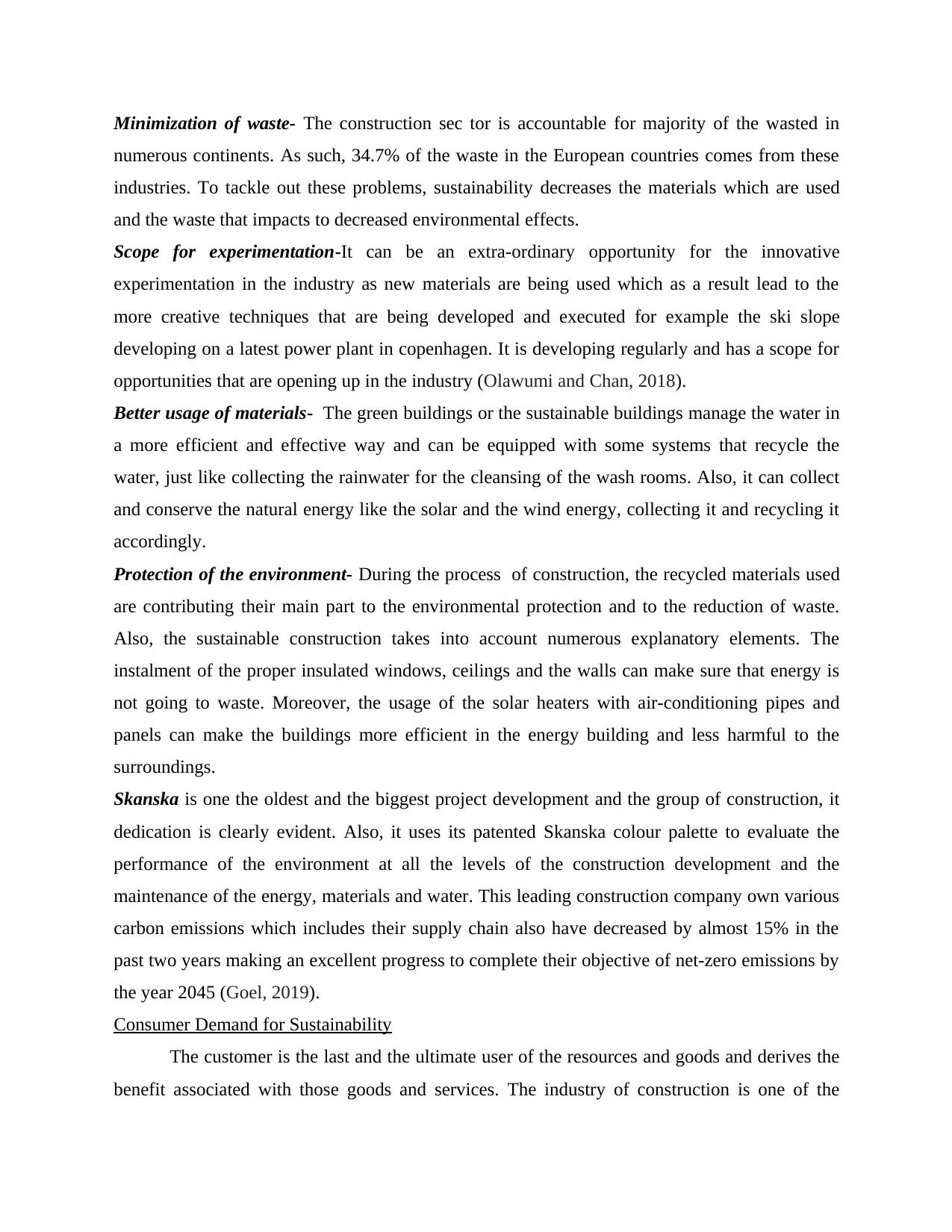
Minimization of waste- The construction sec tor is accountable for majority of the wasted in
numerous continents. As such, 34.7% of the waste in the European countries comes from these
industries. To tackle out these problems, sustainability decreases the materials which are used
and the waste that impacts to decreased environmental effects.
Scope for experimentation-It can be an extra-ordinary opportunity for the innovative
experimentation in the industry as new materials are being used which as a result lead to the
more creative techniques that are being developed and executed for example the ski slope
developing on a latest power plant in copenhagen. It is developing regularly and has a scope for
opportunities that are opening up in the industry (Olawumi and Chan, 2018).
Better usage of materials- The green buildings or the sustainable buildings manage the water in
a more efficient and effective way and can be equipped with some systems that recycle the
water, just like collecting the rainwater for the cleansing of the wash rooms. Also, it can collect
and conserve the natural energy like the solar and the wind energy, collecting it and recycling it
accordingly.
Protection of the environment- During the process of construction, the recycled materials used
are contributing their main part to the environmental protection and to the reduction of waste.
Also, the sustainable construction takes into account numerous explanatory elements. The
instalment of the proper insulated windows, ceilings and the walls can make sure that energy is
not going to waste. Moreover, the usage of the solar heaters with air-conditioning pipes and
panels can make the buildings more efficient in the energy building and less harmful to the
surroundings.
Skanska is one the oldest and the biggest project development and the group of construction, it
dedication is clearly evident. Also, it uses its patented Skanska colour palette to evaluate the
performance of the environment at all the levels of the construction development and the
maintenance of the energy, materials and water. This leading construction company own various
carbon emissions which includes their supply chain also have decreased by almost 15% in the
past two years making an excellent progress to complete their objective of net-zero emissions by
the year 2045 (Goel, 2019).
Consumer Demand for Sustainability
The customer is the last and the ultimate user of the resources and goods and derives the
benefit associated with those goods and services. The industry of construction is one of the
numerous continents. As such, 34.7% of the waste in the European countries comes from these
industries. To tackle out these problems, sustainability decreases the materials which are used
and the waste that impacts to decreased environmental effects.
Scope for experimentation-It can be an extra-ordinary opportunity for the innovative
experimentation in the industry as new materials are being used which as a result lead to the
more creative techniques that are being developed and executed for example the ski slope
developing on a latest power plant in copenhagen. It is developing regularly and has a scope for
opportunities that are opening up in the industry (Olawumi and Chan, 2018).
Better usage of materials- The green buildings or the sustainable buildings manage the water in
a more efficient and effective way and can be equipped with some systems that recycle the
water, just like collecting the rainwater for the cleansing of the wash rooms. Also, it can collect
and conserve the natural energy like the solar and the wind energy, collecting it and recycling it
accordingly.
Protection of the environment- During the process of construction, the recycled materials used
are contributing their main part to the environmental protection and to the reduction of waste.
Also, the sustainable construction takes into account numerous explanatory elements. The
instalment of the proper insulated windows, ceilings and the walls can make sure that energy is
not going to waste. Moreover, the usage of the solar heaters with air-conditioning pipes and
panels can make the buildings more efficient in the energy building and less harmful to the
surroundings.
Skanska is one the oldest and the biggest project development and the group of construction, it
dedication is clearly evident. Also, it uses its patented Skanska colour palette to evaluate the
performance of the environment at all the levels of the construction development and the
maintenance of the energy, materials and water. This leading construction company own various
carbon emissions which includes their supply chain also have decreased by almost 15% in the
past two years making an excellent progress to complete their objective of net-zero emissions by
the year 2045 (Goel, 2019).
Consumer Demand for Sustainability
The customer is the last and the ultimate user of the resources and goods and derives the
benefit associated with those goods and services. The industry of construction is one of the
Paraphrase This Document
Need a fresh take? Get an instant paraphrase of this document with our AI Paraphraser
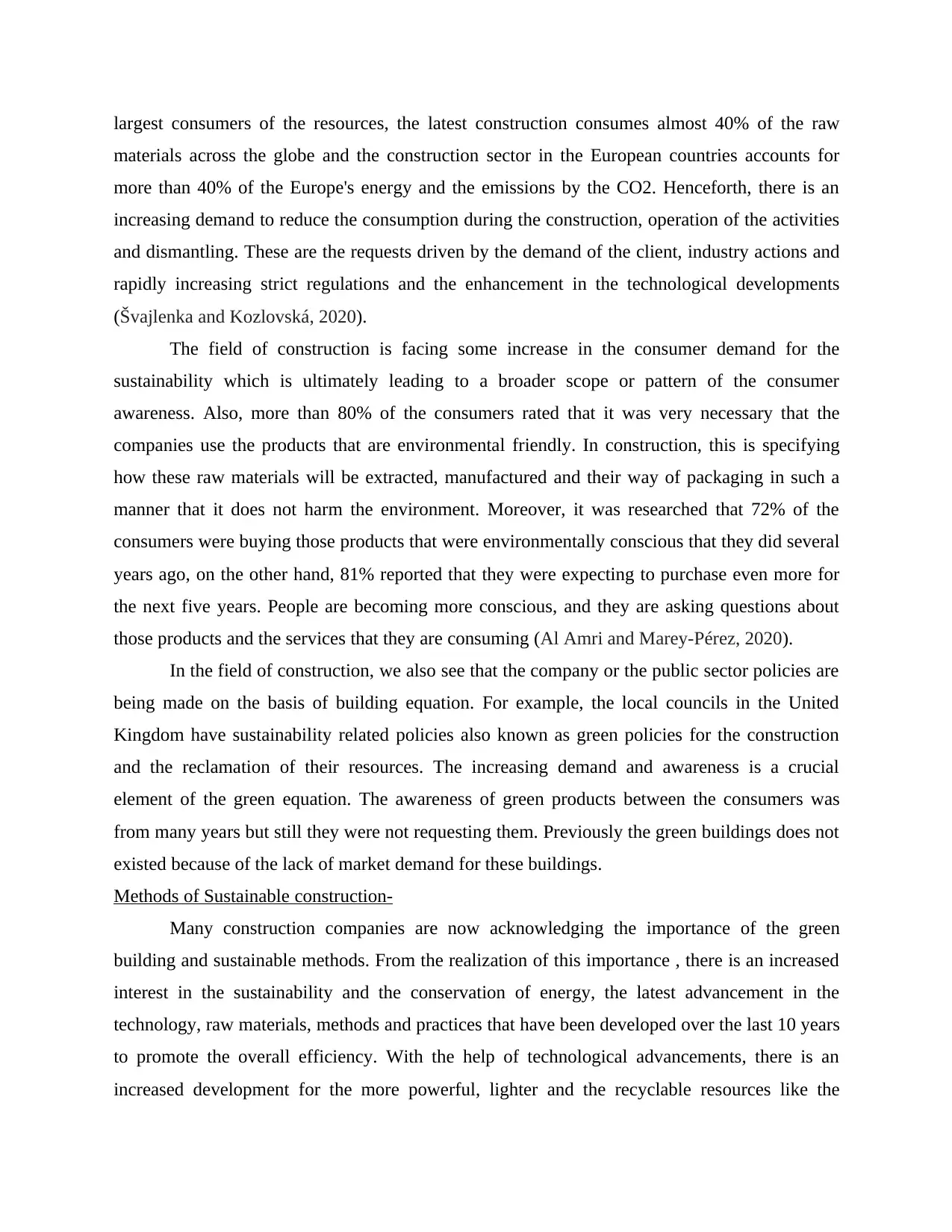
largest consumers of the resources, the latest construction consumes almost 40% of the raw
materials across the globe and the construction sector in the European countries accounts for
more than 40% of the Europe's energy and the emissions by the CO2. Henceforth, there is an
increasing demand to reduce the consumption during the construction, operation of the activities
and dismantling. These are the requests driven by the demand of the client, industry actions and
rapidly increasing strict regulations and the enhancement in the technological developments
(Švajlenka and Kozlovská, 2020).
The field of construction is facing some increase in the consumer demand for the
sustainability which is ultimately leading to a broader scope or pattern of the consumer
awareness. Also, more than 80% of the consumers rated that it was very necessary that the
companies use the products that are environmental friendly. In construction, this is specifying
how these raw materials will be extracted, manufactured and their way of packaging in such a
manner that it does not harm the environment. Moreover, it was researched that 72% of the
consumers were buying those products that were environmentally conscious that they did several
years ago, on the other hand, 81% reported that they were expecting to purchase even more for
the next five years. People are becoming more conscious, and they are asking questions about
those products and the services that they are consuming (Al Amri and Marey-Pérez, 2020).
In the field of construction, we also see that the company or the public sector policies are
being made on the basis of building equation. For example, the local councils in the United
Kingdom have sustainability related policies also known as green policies for the construction
and the reclamation of their resources. The increasing demand and awareness is a crucial
element of the green equation. The awareness of green products between the consumers was
from many years but still they were not requesting them. Previously the green buildings does not
existed because of the lack of market demand for these buildings.
Methods of Sustainable construction-
Many construction companies are now acknowledging the importance of the green
building and sustainable methods. From the realization of this importance , there is an increased
interest in the sustainability and the conservation of energy, the latest advancement in the
technology, raw materials, methods and practices that have been developed over the last 10 years
to promote the overall efficiency. With the help of technological advancements, there is an
increased development for the more powerful, lighter and the recyclable resources like the
materials across the globe and the construction sector in the European countries accounts for
more than 40% of the Europe's energy and the emissions by the CO2. Henceforth, there is an
increasing demand to reduce the consumption during the construction, operation of the activities
and dismantling. These are the requests driven by the demand of the client, industry actions and
rapidly increasing strict regulations and the enhancement in the technological developments
(Švajlenka and Kozlovská, 2020).
The field of construction is facing some increase in the consumer demand for the
sustainability which is ultimately leading to a broader scope or pattern of the consumer
awareness. Also, more than 80% of the consumers rated that it was very necessary that the
companies use the products that are environmental friendly. In construction, this is specifying
how these raw materials will be extracted, manufactured and their way of packaging in such a
manner that it does not harm the environment. Moreover, it was researched that 72% of the
consumers were buying those products that were environmentally conscious that they did several
years ago, on the other hand, 81% reported that they were expecting to purchase even more for
the next five years. People are becoming more conscious, and they are asking questions about
those products and the services that they are consuming (Al Amri and Marey-Pérez, 2020).
In the field of construction, we also see that the company or the public sector policies are
being made on the basis of building equation. For example, the local councils in the United
Kingdom have sustainability related policies also known as green policies for the construction
and the reclamation of their resources. The increasing demand and awareness is a crucial
element of the green equation. The awareness of green products between the consumers was
from many years but still they were not requesting them. Previously the green buildings does not
existed because of the lack of market demand for these buildings.
Methods of Sustainable construction-
Many construction companies are now acknowledging the importance of the green
building and sustainable methods. From the realization of this importance , there is an increased
interest in the sustainability and the conservation of energy, the latest advancement in the
technology, raw materials, methods and practices that have been developed over the last 10 years
to promote the overall efficiency. With the help of technological advancements, there is an
increased development for the more powerful, lighter and the recyclable resources like the
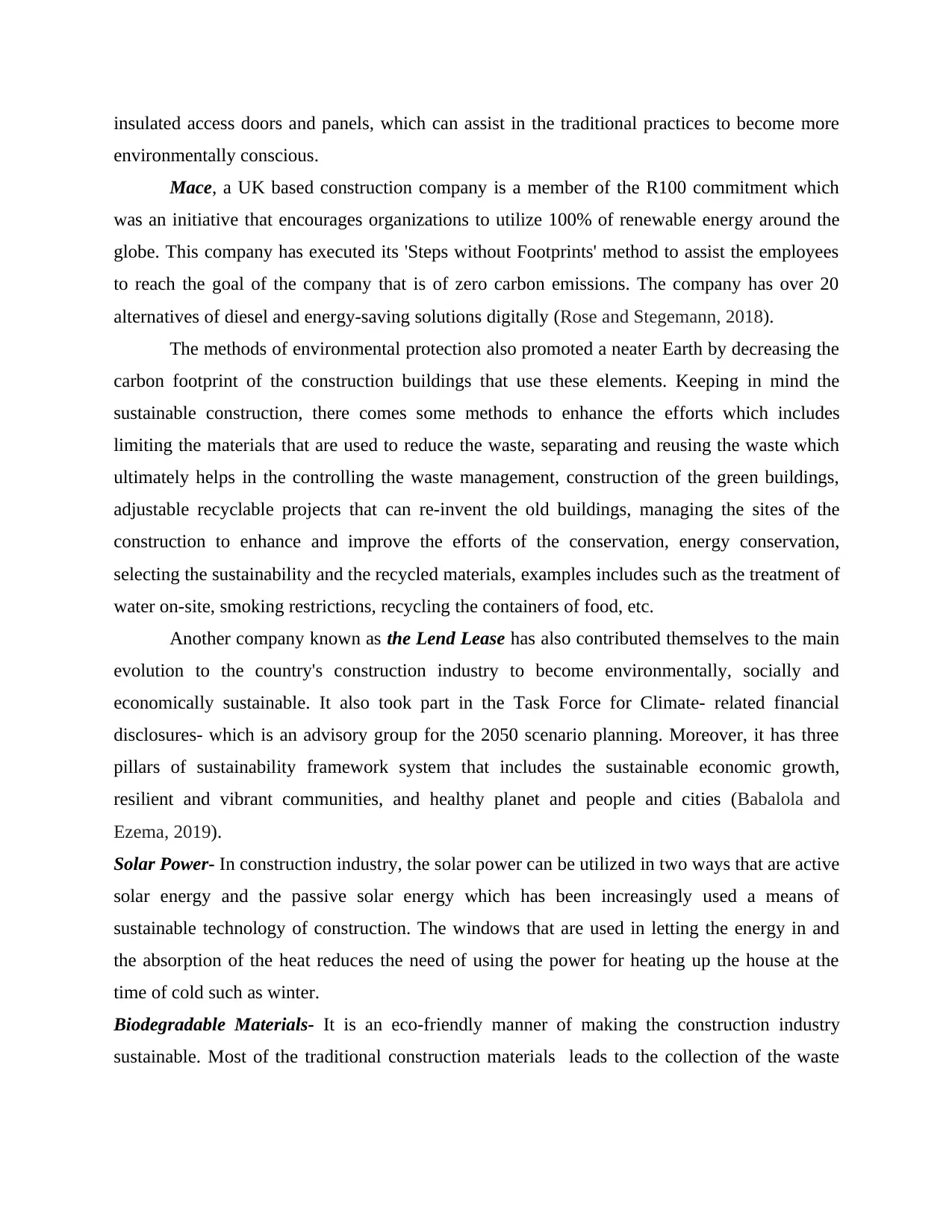
insulated access doors and panels, which can assist in the traditional practices to become more
environmentally conscious.
Mace, a UK based construction company is a member of the R100 commitment which
was an initiative that encourages organizations to utilize 100% of renewable energy around the
globe. This company has executed its 'Steps without Footprints' method to assist the employees
to reach the goal of the company that is of zero carbon emissions. The company has over 20
alternatives of diesel and energy-saving solutions digitally (Rose and Stegemann, 2018).
The methods of environmental protection also promoted a neater Earth by decreasing the
carbon footprint of the construction buildings that use these elements. Keeping in mind the
sustainable construction, there comes some methods to enhance the efforts which includes
limiting the materials that are used to reduce the waste, separating and reusing the waste which
ultimately helps in the controlling the waste management, construction of the green buildings,
adjustable recyclable projects that can re-invent the old buildings, managing the sites of the
construction to enhance and improve the efforts of the conservation, energy conservation,
selecting the sustainability and the recycled materials, examples includes such as the treatment of
water on-site, smoking restrictions, recycling the containers of food, etc.
Another company known as the Lend Lease has also contributed themselves to the main
evolution to the country's construction industry to become environmentally, socially and
economically sustainable. It also took part in the Task Force for Climate- related financial
disclosures- which is an advisory group for the 2050 scenario planning. Moreover, it has three
pillars of sustainability framework system that includes the sustainable economic growth,
resilient and vibrant communities, and healthy planet and people and cities (Babalola and
Ezema, 2019).
Solar Power- In construction industry, the solar power can be utilized in two ways that are active
solar energy and the passive solar energy which has been increasingly used a means of
sustainable technology of construction. The windows that are used in letting the energy in and
the absorption of the heat reduces the need of using the power for heating up the house at the
time of cold such as winter.
Biodegradable Materials- It is an eco-friendly manner of making the construction industry
sustainable. Most of the traditional construction materials leads to the collection of the waste
environmentally conscious.
Mace, a UK based construction company is a member of the R100 commitment which
was an initiative that encourages organizations to utilize 100% of renewable energy around the
globe. This company has executed its 'Steps without Footprints' method to assist the employees
to reach the goal of the company that is of zero carbon emissions. The company has over 20
alternatives of diesel and energy-saving solutions digitally (Rose and Stegemann, 2018).
The methods of environmental protection also promoted a neater Earth by decreasing the
carbon footprint of the construction buildings that use these elements. Keeping in mind the
sustainable construction, there comes some methods to enhance the efforts which includes
limiting the materials that are used to reduce the waste, separating and reusing the waste which
ultimately helps in the controlling the waste management, construction of the green buildings,
adjustable recyclable projects that can re-invent the old buildings, managing the sites of the
construction to enhance and improve the efforts of the conservation, energy conservation,
selecting the sustainability and the recycled materials, examples includes such as the treatment of
water on-site, smoking restrictions, recycling the containers of food, etc.
Another company known as the Lend Lease has also contributed themselves to the main
evolution to the country's construction industry to become environmentally, socially and
economically sustainable. It also took part in the Task Force for Climate- related financial
disclosures- which is an advisory group for the 2050 scenario planning. Moreover, it has three
pillars of sustainability framework system that includes the sustainable economic growth,
resilient and vibrant communities, and healthy planet and people and cities (Babalola and
Ezema, 2019).
Solar Power- In construction industry, the solar power can be utilized in two ways that are active
solar energy and the passive solar energy which has been increasingly used a means of
sustainable technology of construction. The windows that are used in letting the energy in and
the absorption of the heat reduces the need of using the power for heating up the house at the
time of cold such as winter.
Biodegradable Materials- It is an eco-friendly manner of making the construction industry
sustainable. Most of the traditional construction materials leads to the collection of the waste
⊘ This is a preview!⊘
Do you want full access?
Subscribe today to unlock all pages.

Trusted by 1+ million students worldwide
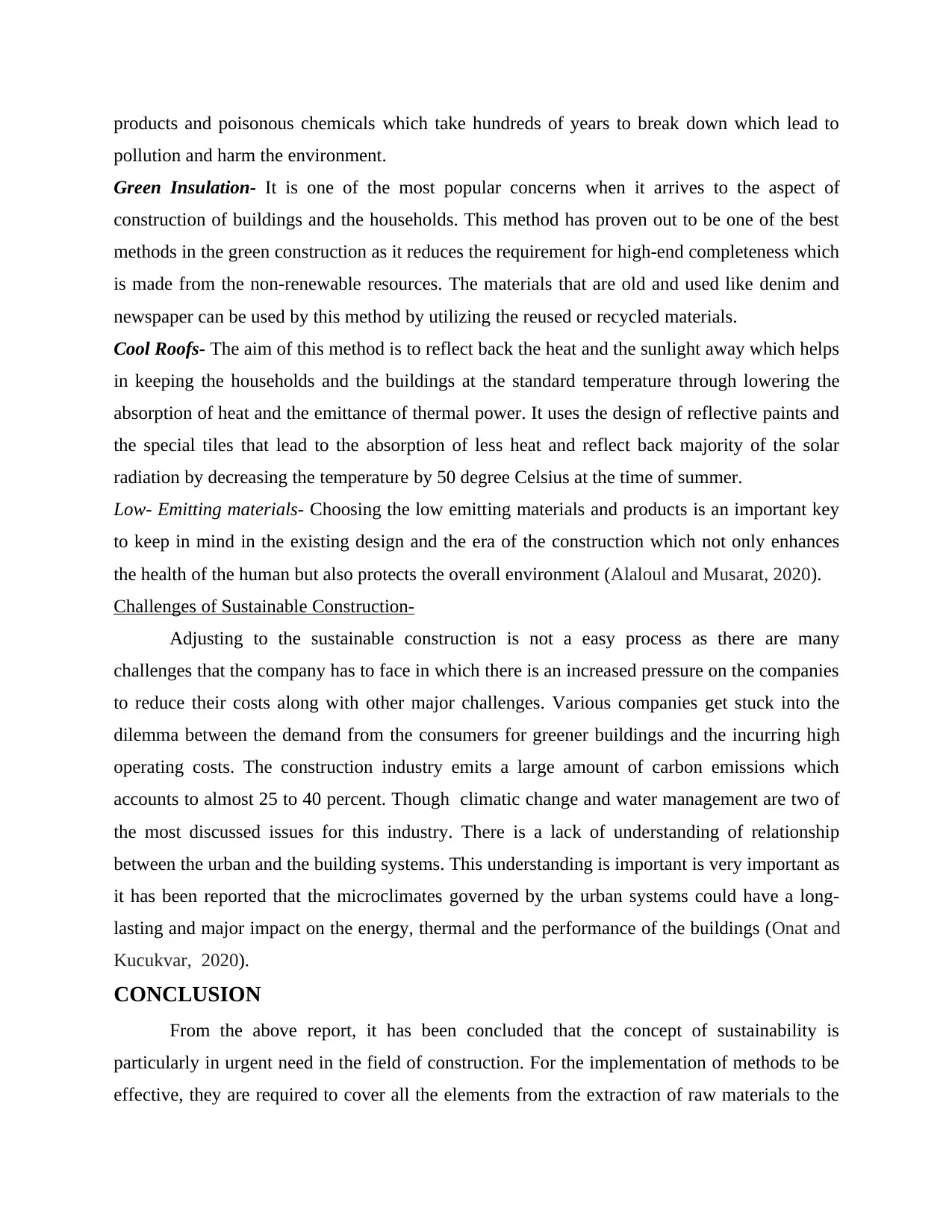
products and poisonous chemicals which take hundreds of years to break down which lead to
pollution and harm the environment.
Green Insulation- It is one of the most popular concerns when it arrives to the aspect of
construction of buildings and the households. This method has proven out to be one of the best
methods in the green construction as it reduces the requirement for high-end completeness which
is made from the non-renewable resources. The materials that are old and used like denim and
newspaper can be used by this method by utilizing the reused or recycled materials.
Cool Roofs- The aim of this method is to reflect back the heat and the sunlight away which helps
in keeping the households and the buildings at the standard temperature through lowering the
absorption of heat and the emittance of thermal power. It uses the design of reflective paints and
the special tiles that lead to the absorption of less heat and reflect back majority of the solar
radiation by decreasing the temperature by 50 degree Celsius at the time of summer.
Low- Emitting materials- Choosing the low emitting materials and products is an important key
to keep in mind in the existing design and the era of the construction which not only enhances
the health of the human but also protects the overall environment (Alaloul and Musarat, 2020).
Challenges of Sustainable Construction-
Adjusting to the sustainable construction is not a easy process as there are many
challenges that the company has to face in which there is an increased pressure on the companies
to reduce their costs along with other major challenges. Various companies get stuck into the
dilemma between the demand from the consumers for greener buildings and the incurring high
operating costs. The construction industry emits a large amount of carbon emissions which
accounts to almost 25 to 40 percent. Though climatic change and water management are two of
the most discussed issues for this industry. There is a lack of understanding of relationship
between the urban and the building systems. This understanding is important is very important as
it has been reported that the microclimates governed by the urban systems could have a long-
lasting and major impact on the energy, thermal and the performance of the buildings (Onat and
Kucukvar, 2020).
CONCLUSION
From the above report, it has been concluded that the concept of sustainability is
particularly in urgent need in the field of construction. For the implementation of methods to be
effective, they are required to cover all the elements from the extraction of raw materials to the
pollution and harm the environment.
Green Insulation- It is one of the most popular concerns when it arrives to the aspect of
construction of buildings and the households. This method has proven out to be one of the best
methods in the green construction as it reduces the requirement for high-end completeness which
is made from the non-renewable resources. The materials that are old and used like denim and
newspaper can be used by this method by utilizing the reused or recycled materials.
Cool Roofs- The aim of this method is to reflect back the heat and the sunlight away which helps
in keeping the households and the buildings at the standard temperature through lowering the
absorption of heat and the emittance of thermal power. It uses the design of reflective paints and
the special tiles that lead to the absorption of less heat and reflect back majority of the solar
radiation by decreasing the temperature by 50 degree Celsius at the time of summer.
Low- Emitting materials- Choosing the low emitting materials and products is an important key
to keep in mind in the existing design and the era of the construction which not only enhances
the health of the human but also protects the overall environment (Alaloul and Musarat, 2020).
Challenges of Sustainable Construction-
Adjusting to the sustainable construction is not a easy process as there are many
challenges that the company has to face in which there is an increased pressure on the companies
to reduce their costs along with other major challenges. Various companies get stuck into the
dilemma between the demand from the consumers for greener buildings and the incurring high
operating costs. The construction industry emits a large amount of carbon emissions which
accounts to almost 25 to 40 percent. Though climatic change and water management are two of
the most discussed issues for this industry. There is a lack of understanding of relationship
between the urban and the building systems. This understanding is important is very important as
it has been reported that the microclimates governed by the urban systems could have a long-
lasting and major impact on the energy, thermal and the performance of the buildings (Onat and
Kucukvar, 2020).
CONCLUSION
From the above report, it has been concluded that the concept of sustainability is
particularly in urgent need in the field of construction. For the implementation of methods to be
effective, they are required to cover all the elements from the extraction of raw materials to the
Paraphrase This Document
Need a fresh take? Get an instant paraphrase of this document with our AI Paraphraser
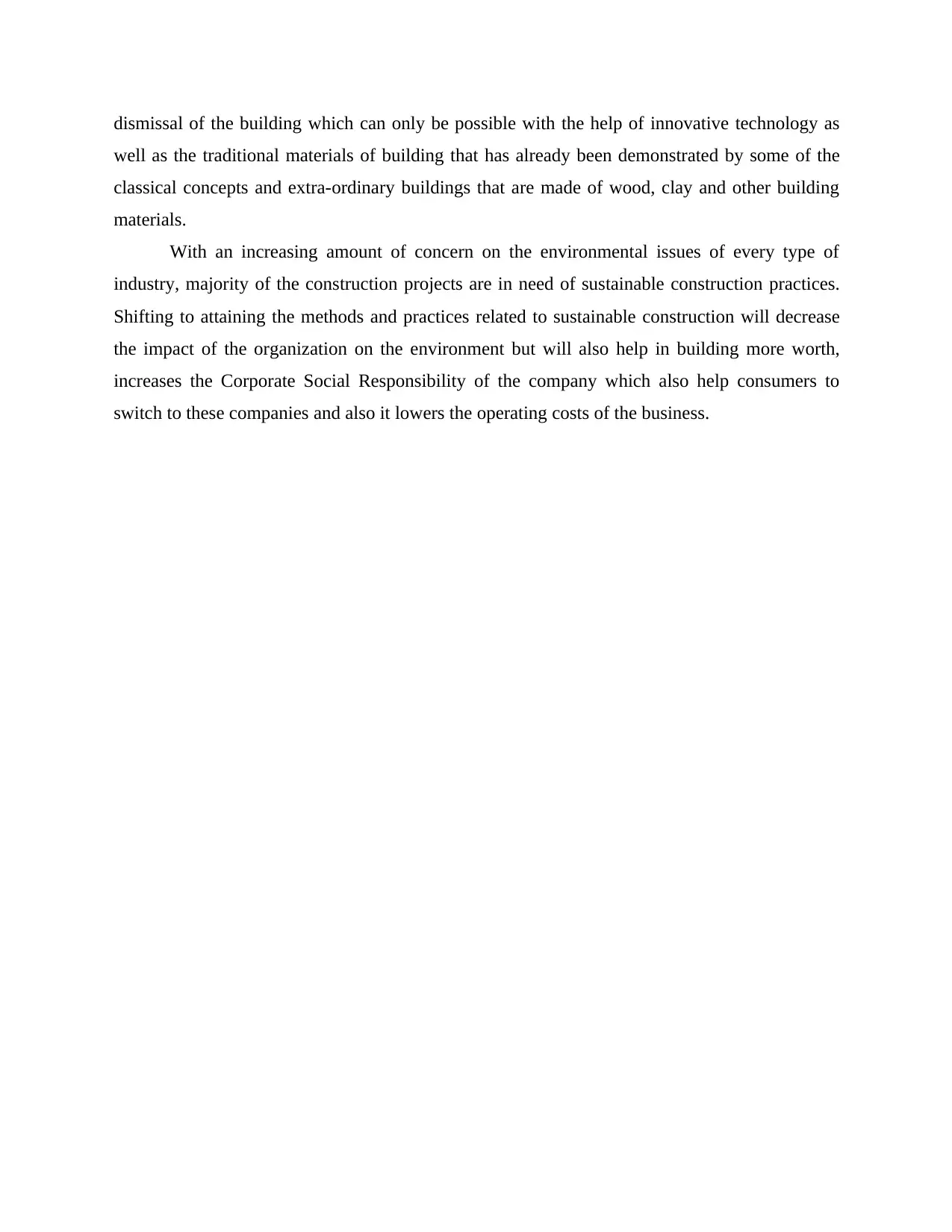
dismissal of the building which can only be possible with the help of innovative technology as
well as the traditional materials of building that has already been demonstrated by some of the
classical concepts and extra-ordinary buildings that are made of wood, clay and other building
materials.
With an increasing amount of concern on the environmental issues of every type of
industry, majority of the construction projects are in need of sustainable construction practices.
Shifting to attaining the methods and practices related to sustainable construction will decrease
the impact of the organization on the environment but will also help in building more worth,
increases the Corporate Social Responsibility of the company which also help consumers to
switch to these companies and also it lowers the operating costs of the business.
well as the traditional materials of building that has already been demonstrated by some of the
classical concepts and extra-ordinary buildings that are made of wood, clay and other building
materials.
With an increasing amount of concern on the environmental issues of every type of
industry, majority of the construction projects are in need of sustainable construction practices.
Shifting to attaining the methods and practices related to sustainable construction will decrease
the impact of the organization on the environment but will also help in building more worth,
increases the Corporate Social Responsibility of the company which also help consumers to
switch to these companies and also it lowers the operating costs of the business.
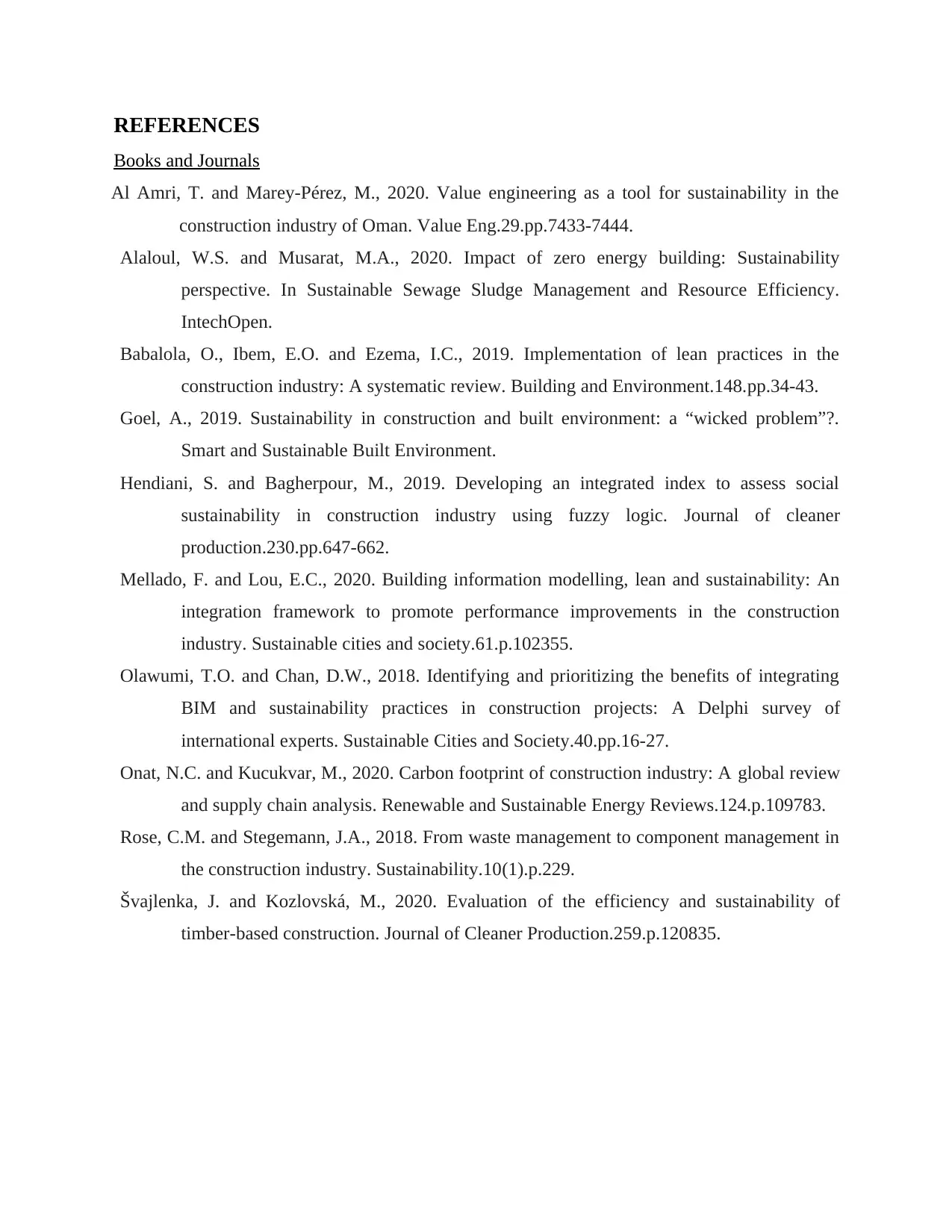
REFERENCES
Books and Journals
Al Amri, T. and Marey-Pérez, M., 2020. Value engineering as a tool for sustainability in the
construction industry of Oman. Value Eng.29.pp.7433-7444.
Alaloul, W.S. and Musarat, M.A., 2020. Impact of zero energy building: Sustainability
perspective. In Sustainable Sewage Sludge Management and Resource Efficiency.
IntechOpen.
Babalola, O., Ibem, E.O. and Ezema, I.C., 2019. Implementation of lean practices in the
construction industry: A systematic review. Building and Environment.148.pp.34-43.
Goel, A., 2019. Sustainability in construction and built environment: a “wicked problem”?.
Smart and Sustainable Built Environment.
Hendiani, S. and Bagherpour, M., 2019. Developing an integrated index to assess social
sustainability in construction industry using fuzzy logic. Journal of cleaner
production.230.pp.647-662.
Mellado, F. and Lou, E.C., 2020. Building information modelling, lean and sustainability: An
integration framework to promote performance improvements in the construction
industry. Sustainable cities and society.61.p.102355.
Olawumi, T.O. and Chan, D.W., 2018. Identifying and prioritizing the benefits of integrating
BIM and sustainability practices in construction projects: A Delphi survey of
international experts. Sustainable Cities and Society.40.pp.16-27.
Onat, N.C. and Kucukvar, M., 2020. Carbon footprint of construction industry: A global review
and supply chain analysis. Renewable and Sustainable Energy Reviews.124.p.109783.
Rose, C.M. and Stegemann, J.A., 2018. From waste management to component management in
the construction industry. Sustainability.10(1).p.229.
Švajlenka, J. and Kozlovská, M., 2020. Evaluation of the efficiency and sustainability of
timber-based construction. Journal of Cleaner Production.259.p.120835.
Books and Journals
Al Amri, T. and Marey-Pérez, M., 2020. Value engineering as a tool for sustainability in the
construction industry of Oman. Value Eng.29.pp.7433-7444.
Alaloul, W.S. and Musarat, M.A., 2020. Impact of zero energy building: Sustainability
perspective. In Sustainable Sewage Sludge Management and Resource Efficiency.
IntechOpen.
Babalola, O., Ibem, E.O. and Ezema, I.C., 2019. Implementation of lean practices in the
construction industry: A systematic review. Building and Environment.148.pp.34-43.
Goel, A., 2019. Sustainability in construction and built environment: a “wicked problem”?.
Smart and Sustainable Built Environment.
Hendiani, S. and Bagherpour, M., 2019. Developing an integrated index to assess social
sustainability in construction industry using fuzzy logic. Journal of cleaner
production.230.pp.647-662.
Mellado, F. and Lou, E.C., 2020. Building information modelling, lean and sustainability: An
integration framework to promote performance improvements in the construction
industry. Sustainable cities and society.61.p.102355.
Olawumi, T.O. and Chan, D.W., 2018. Identifying and prioritizing the benefits of integrating
BIM and sustainability practices in construction projects: A Delphi survey of
international experts. Sustainable Cities and Society.40.pp.16-27.
Onat, N.C. and Kucukvar, M., 2020. Carbon footprint of construction industry: A global review
and supply chain analysis. Renewable and Sustainable Energy Reviews.124.p.109783.
Rose, C.M. and Stegemann, J.A., 2018. From waste management to component management in
the construction industry. Sustainability.10(1).p.229.
Švajlenka, J. and Kozlovská, M., 2020. Evaluation of the efficiency and sustainability of
timber-based construction. Journal of Cleaner Production.259.p.120835.
⊘ This is a preview!⊘
Do you want full access?
Subscribe today to unlock all pages.

Trusted by 1+ million students worldwide
1 out of 9
Related Documents
Your All-in-One AI-Powered Toolkit for Academic Success.
+13062052269
info@desklib.com
Available 24*7 on WhatsApp / Email
![[object Object]](/_next/static/media/star-bottom.7253800d.svg)
Unlock your academic potential
Copyright © 2020–2025 A2Z Services. All Rights Reserved. Developed and managed by ZUCOL.





